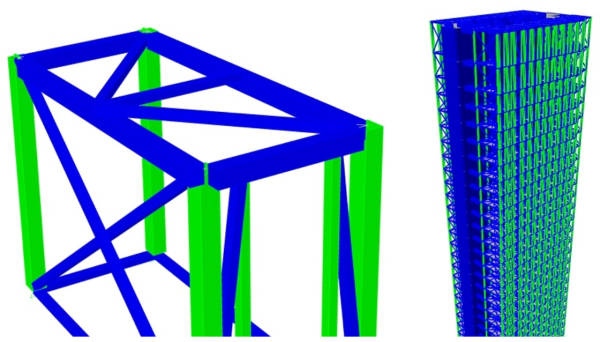Plug and play skyscrapers

|
| Typical steel module (left) was modelled in a 40-storey building (right) |
Contents |
[edit] Introduction
Off-site manufacture of ‘plug and play’ modules is fast gaining ground in the housing and plant sectors. What are the engineering challenges for using it for high-rise buildings?
Modular construction, in which complete assemblies – ranging from plant rooms to apartments – are manufactured and tested off-site and then simply slotted into position on-site, is revolutionising construction worldwide.
Benefits include shorter construction, greater safety, reduced waste and higher performance. It comes under various names, including ‘modern methods of construction’ in the UK, ‘permanent modular building’ in the USA, ‘prefabricated prefinished volumetric construction’ in Singapore and ‘modular integrated construction’ in Hong Kong.
[edit] Engineering challenges
However, devising modular systems for high-rise buildings is more technically challenging than those currently used for low- to medium-rise structures, particularly where space is at a premium and strong winds and seismic loading are likely.
Lifting and handling of modules is also a major concern, so reducing module weight is a priority. However, reducing the self-weight may result in excessive tension uplift under strong winds and lead to non-linear behaviour during earthquakes.
In addition, the lateral stability of modular buildings is primarily provided by a reinforced concrete stair and lift core. For high-rise structures, stability can be increased by adding steel outrigger arms to the core and steel edge columns, but analysis of the stresses induced in the modules becomes highly complex.
[edit] Solutions and recommendations
The University of Hong Kong recently carried out a feasibility study for the Hong Kong government on the use of modular construction for high-rise buildings.
Structural schemes for 31–40-storey buildings using commonly-manufactured steel modules were numerically modelled in the Etabs software and analysed against codified critical wind loads.
The results showed that modular high-rise buildings are feasible regarding structural stability – that is, they can satisfy the limitations in top-storey and inter-storey drift due to wind loads.
This however depends on careful design of the core wall layout, core wall thickness and connections between the modules and the core.
Modules with one side directly connected to the core are recommended so that the majority of lateral loads can be transferred to the core by each module independently.
Also, these connections should be designed as pin-ended in the vertical direction. As a lower-bound approach, pin-ended connections were used in the numerical model and were further checked against finite-element analysis using Abaqus in terms of stiffness, load capacity, deformation and stress distribution.
[edit] Higher strength materials
In addition, high-strength steel columns of grades S690 or even S960 can be used for manufacturing the modules to ensure sufficient load-carrying capacity.
For concrete modules, adopting fibre-reinforced concrete walls and/or slabs can help to reduce structural weight to an optimum level.
Authors: Wei Pan, Ray Su, Yancheng Cai and Ben Young, The University of Hong Kong. This article is based on the authors’ briefing article issue 174 CE4 of the ICE Civil Engineering journal. November 2018. Source: https://www.ice.org.uk/news-and-insight/the-civil-engineer/december-2018/plug-and-play-skyscrapers-can-it-be-done
--The Institution of Civil Engineers
[edit] Related articles on Designing Buildings Wiki
- Advanced construction technology.
- Advanced manufacturing.
- BSRIA launches Offsite Construction for Building Services topic guide.
- How to make projects off-site ready.
- ICE articles on Designing Buildings Wiki
- Modern methods of construction.
- Modular buildings.
- Off-site construction.
- Offsite manufacturing.
- Off-site prefabrication of buildings: A guide to connection choices.
- Prefabrication.
- Skyscraper.
- The Institution of Civil Engineers.
Featured articles and news
One of the most impressive Victorian architects. Book review.
RTPI leader to become new CIOB Chief Executive Officer
Dr Victoria Hills MRTPI, FICE to take over after Caroline Gumble’s departure.
Social and affordable housing, a long term plan for delivery
The “Delivering a Decade of Renewal for Social and Affordable Housing” strategy sets out future path.
A change to adoptive architecture
Effects of global weather warming on architectural detailing, material choice and human interaction.
The proposed publicly owned and backed subsidiary of Homes England, to facilitate new homes.
How big is the problem and what can we do to mitigate the effects?
Overheating guidance and tools for building designers
A number of cool guides to help with the heat.
The UK's Modern Industrial Strategy: A 10 year plan
Previous consultation criticism, current key elements and general support with some persisting reservations.
Building Safety Regulator reforms
New roles, new staff and a new fast track service pave the way for a single construction regulator.
Architectural Technologist CPDs and Communications
CIAT CPD… and how you can do it!
Cooling centres and cool spaces
Managing extreme heat in cities by directing the public to places for heat stress relief and water sources.
Winter gardens: A brief history and warm variations
Extending the season with glass in different forms and terms.
Restoring Great Yarmouth's Winter Gardens
Transforming one of the least sustainable constructions imaginable.
Construction Skills Mission Board launch sector drive
Newly formed government and industry collaboration set strategy for recruiting an additional 100,000 construction workers a year.
New Architects Code comes into effect in September 2025
ARB Architects Code of Conduct and Practice available with ongoing consultation regarding guidance.
Welsh Skills Body (Medr) launches ambitious plan
The new skills body brings together funding and regulation of tertiary education and research for the devolved nation.
Paul Gandy FCIOB announced as next CIOB President
Former Tilbury Douglas CEO takes helm.























